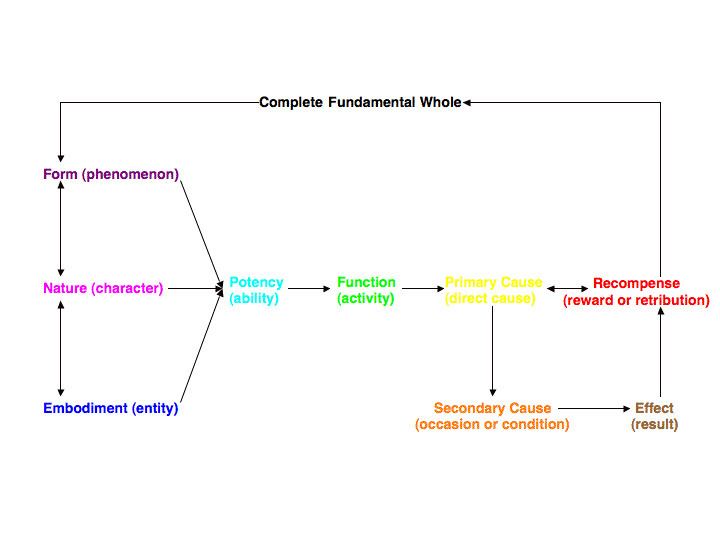 | ||
The Ten suchnesses (Chinese: 十如是 shí rúshì; Japanese: 十如是 jū nyoze) are a Mahayana doctrine which is important, as well as unique, to that of the Tiantai (Tendai) and Nichiren Buddhist schools of thought. The doctrine is derived from a passage found within the second chapter of Kumarajivas Chinese translation of the Lotus Sutra, that "characterizes the ultimate reality (literally, “real mark”) of all dharmas in terms of ten suchnesses." This concept is also known as the ten reality aspects, ten factors of life, or the Reality of all Existence.
Contents
Origin
The list of ten suchnesses is neither found in Dharmarakshas Chinese translation nor in the Tibetan edition or any of the extant Sanskrit manuscripts.
The Sanskrit editions of the Lotus Sutra list only five elements:
Only the Thus Come One knows all the dharmas:
what are the dharmas, how are the dharmas, what are the dharmas like, of what characteristics are the dharmas, of what nature are the dharmas; what they are, how they are, what they are like, of what characteristics they are, of what nature are the dharmas, only the Thus Come One has had direct experience in those dharmas.
Kumarajiva translates the passage in chapter two as:
Only a Buddha and a Buddha can exhaust their reality, namely the suchness of the dharmas, the suchness of their marks, the suchness of their nature, the suchness of their substance, the suchness of their powers, the suchness of their functions, the suchness of their causes, the suchness of their conditions, the suchness of their effects, the suchness of their retributions, and the absolute identity of their beginning and end.
The discrepancy between Kumarajivas translation and the Sanskrit editions might be due to Kumarajivas use of a manuscript variant but Groner and Stone suggest that "the expansion of this list to ten is probably Kumarajlvas invention and may well be presaged in a passage in the Dazhidulun that includes nine aspects."
Definitions
The following definitions are given by the Soka Gakkai English Buddhist Dictionary Committee and describe what each suchness means in more detail:
The above three suchnesses describe the reality of life itself. The next six suchnesses, from the fourth through the ninth, explain the functions and workings of life.
Interpretation
The ten suchnesses, or categories, are what led the sixth century Chinese Buddhist philosopher Zhiyi to establish the doctrine of the "three thousand [worlds] in one thought." The Tiantai school describes ten dharma realms (ch. shi fajie) of sentient beings, the realms of hell dwellers, hungry ghosts, beasts, asuras, humans, gods (devas), sravakas, pratyekabuddhas, bodhisattvas and Buddhas. According to Zhiyi, each of these ten dharma realms mutually includes all of the other realms, resulting in 100 "states of existence" that share the characteristics of the ten suchnesses. The one thousand suchnesses are active in each of the three spheres (the five skandhas, sentient beings,and their environment) forming three thousand worlds in one thought moment.
Nichiren regarded the doctrine of "three thousand [worlds] in one thought" (ichinen-sanzen) as the fundamental principle of the Lotus Sutra and the very essence of the Buddha's teachings. He wrote in his work Kaimoku-shō (Essay on the Eye-opener) concerning ichinen-sanzen: "The very doctrine of the Three Thousand Realms in One Mind of the Tendai sect appears to be the way to lead man to buddhahood."
Nikkyo Niwano states that the principle of the Reality of All Existence not only analyzes what modern science would analyze in physical substances to the extent of subatomic particles, but also extends to mental state. Accordingly, everyone's mind has existing within it the ten realms of existence which are said to be found within one another. The suchnesses reveal the deepest reality inherent within all things, and, consequently, innumerable embodied substances existing in the universe are interrelated with all things. The suchnesses, one through nine, operate according to the law of the universal truth, namely from the "complete fundamental whole" under which no one, no thing, and no function can depart. All things, including man, along with their relations with everything else are formed from the Reality of All Existence that is the Ten Suchnesses.
